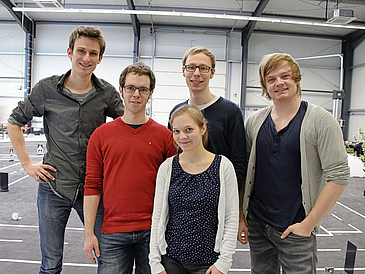Watching the OptiCar moving into a parking space will make you envious. One, two, three quick turns of the wheel and the little roadster fits perfectly into the parking slot. The 1:8-scale model automobile drives itself without remote-control interference. Ultrasonic sensors and mini cameras act as its “senses”, and the rest is programmed by five students enrolled in Technomathematik [roughly translated: industrial mathematics]. Competing against nine other teams during a competition held in Ingolstadt, they accomplished a respectable fourth place – not bad for a first-time attempt.
“The model can only do what it is told. It’s the code that makes it intelligent”, explains the spokesperson for the OptiCar team, Andreas Cobus. The five students spent six months developing the software that makes it capable of autonomously reacting to its environment. How did it all begin? Professor Christof Büskens, leader of the work group “Optimization and Optimal Control” at the University of Bremen’s Center for Industrial Mathematics, first told his students about the “Audi Autonomous Driving Cup” competition in Ingolstadt. “We spent two weeks working out a software structure for an autonomous vehicle”, says Matthias Rick, one of the five highly motivated industrial mathematicians. There was joy and no little surprise when Audi announced they had been selected to take part in the competition because the University of Bremen team were not the only ones keen to participate. Andreas Cobus and Alexander Probst then traveled to Ingolstadt to pick up two sophistically equipped model automobiles worth a good 2,000 euros each.
Sundays, evenings, almost all the time
Sure, their play instinct was awakened when they unpacked the blue Type Q5 models. The task of programming turned out to have its pitfalls, though. “We had never before been involved in image processing”, says Niels Backfisch; and it took a while to become acquainted with the code prescribed by Audi. It would have helped if they had had computer scientists in the team. Anyhow, they eventually managed to get over such obstacles. “We are very grateful to Joachim Clemens from the area of cognitive neuroinformatics for his valuable input”, says Cobus. He was able to help with his experience gained from working with the RoboCup robots. Then it seemed that everyone became sort of addicted, as Niels Backfisch jokingly puts it, and they set down to program the fine details. Matthias Rick describes just how wholehearted their involvement had become, “We found ourselves working all the time, even on Sundays”. And team spokesperson Andreas Cobus, the only undergraduate member of the team, freely admits that his life was reduced to “Half automobile, half studying”. 20 percent of the work was dedicated to programming, and the rest to running tests with the “Opti”, as they call it. It had to be made ready for every eventuality: reading traffic signs, recognizing obstructions, complying with the rules of the road … and so no and so forth.
Offer: Making their successors fit for future competitions
Then the time arrived for the exciting competition in Ingolstadt on March 22. And something no one had reckoned with: A crossroads immediately after a sharp bend in the road. Opti’s speed of reaction was not up to this – and it simply sped across. “Won’t happen again”, exclaims Backfisch. The inventive five have a plan: They hope that Audi will run the competition again next year – this March was the second time. If that happens, the Bremen students want to act as coaches. “There will have to be at least two computer scientists on board next time, though”, says Cobus. So if anyone is interested in taking part they might as well get in touch with him right away. Unfortunately, the model automobiles had to be left in Ingolstadt, though.
Connecting link in interdisciplinary teams
One question remains: What precisely is Technomathematik? Backfisch helps with the English translation “industrial mathematics”, which describes mathematics with a technical focus. “Mathematics is the Latin of the natural sciences and engineering; the working language, so to speak. Working in interdisciplinary teams, mathematicians like us are the connecting link between research and practical application”. And it seems the committed students don’t have to worry about their future: Audi has already proposed topics for their Master’s theses.

